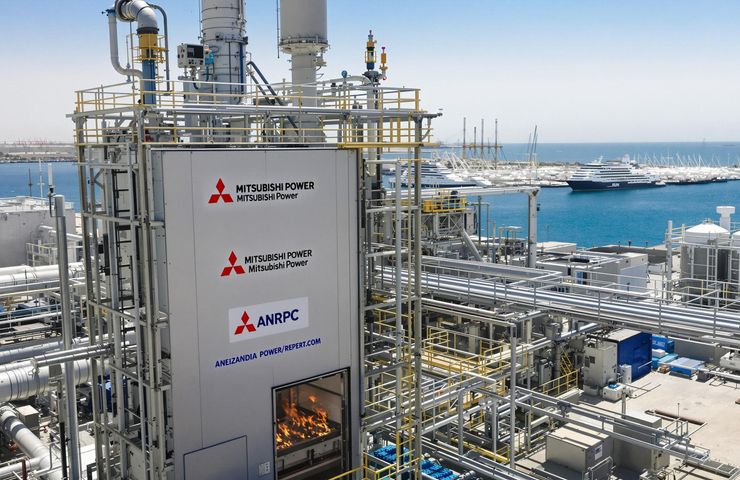
Hydrogen Boiler Conversion: Mitsubishi Power’s Game-Changer in Egypt
August 7, 2025Ever imagined an industrial-scale switch from fossil fuels to hydrogen without tearing everything down? Hold onto your hats—Mitsubishi Power, the trailblazing arm of Mitsubishi Heavy Industries, just pulled it off at the Alexandria National Refining and Petrochemicals Company (ANRPC) in Alexandria, Egypt. This Mediterranean hub with over 5.4 million people has flipped the script: in August 2025, they wrapped up a fully engineered, turnkey project—design, supply, installation, and commissioning—that converted a 100-tonne-per-hour industrial boiler from heavy fuel oil and natural gas to 100% hydrogen. We’re talking about redirecting some 14,000 tonnes of hydrogen-rich gases that used to go up in flames, saving roughly 24,000 tonnes of natural gas, and cutting about 65,000 tonnes of CO₂ each year. It’s the first Hydrogen Boiler Conversion not just in Egypt but across the whole Middle East and Africa. Say hello to Industrial Decarbonization on steroids.
Historical Context
For decades, Egypt’s big industries have leaned heavily on oil and natural gas, with refineries and petrochemical plants hugging the Mediterranean coast. Alexandria, in particular, has powered local economies but also churned out a good chunk of the country’s carbon emissions. Fast forward to 2016, and the Egyptian government rolled out its Vision 2030 roadmap to slash greenhouse gas intensity and diversify the energy mix. Researchers and demo projects started dabbling in hydrogen by 2022, testing small burners and lab-scale setups. But these pilots stayed small—still stuck on the sidelines due to steep costs, feedstock snags, and infrastructure headaches.
Enter 2024: the policy winds shifted. Incentives for clean fuels popped up, carbon pricing frameworks took shape, and hydrogen project permits got streamlined. It set the stage perfectly—but nobody had cracked the code on a 100 tph hydrogen boiler conversion until now. Mitsubishi Power’s team at ANRPC proved you can retrofit decades-old boilers without bleeding cash on massive upfront CAPEX and that process off-gases make an unbeatable low-cost hydrogen source. With backing from international funders and tech partners, this project shows what true collaboration—Japanese engineering muscle meets Egyptian ambition—can achieve in industrial decarbonization.
What This Means
Let’s face it: hydrogen has been the buzzword for a while, but heavy industries have largely stayed hooked on oil and gas. In 2023, Egypt’s refining sector belched out nearly 10 million tonnes of CO₂, with industrial emissions making up almost a third of the nation’s total footprint. Here’s the bottom line on this milestone:
- Massive emissions cut: roughly 65,000 tonnes of CO₂ slashed every year—like yanking over 14,000 cars off the road.
- Energy security boost: cutting about 24,000 tonnes of natural gas annually, freeing up local gas supplies for power plants and homes.
- Zero-waste philosophy: transforming around 14,000 tonnes of hydrogen-rich by-product gas into valuable fuel instead of flaring it away.
- Competitive edge: trimming fuel and carbon compliance bills gives ANRPC a healthier bottom line.
- Pioneering blueprint: stepping beyond pilots into a live, industrial-scale rollout that others can copy.
This isn’t just another green pilot; it’s a real-world answer that plugs right into Egypt’s Vision 2030 goals. It sends a crystal-clear signal: Hydrogen Boiler Conversion is no longer a pie-in-the-sky idea—it’s business as usual.
The Technology: The Magic Ingredient
So, what’s behind this hydrogen makeover? It boils down to sharp retrofitting and precision engineering:
- Hydrogen-optimized burners with micro-engineered nozzles—because hydrogen’s flame speed is 2–3 times faster than natural gas, you need spot-on mixing to keep things stable at high loads.
- A state-of-the-art control platform that tweaks temperature, pressure, and flow on the fly—guaranteeing top efficiency and safety around the clock.
- Materials and safety upgrades tailored to hydrogen’s quirks: high diffusion rates, embrittlement risks, and built-in leak detection.
- Seamless integration with the existing boiler house piping, pumps, and instrumentation—no huge civil works, just smart engineering that swings open the doors to hydrogen.
The feedstock? It comes straight from ANRPC’s own hydrogen-rich process gases—by-products that would otherwise be flared or vented. Mitsubishi Power’s squad cleaned and conditioned these streams, cranked up their calorific value, and delivered a plug-and-play hydrogen supply to the boiler. The outcome: zero carbon emissions, full steam output, and no need for offsite hydrogen carriers. That’s Industrial Decarbonization in action.
Collateral Impacts
Beyond the headline numbers, this switch lights up a chain reaction of benefits:
- Skill-building boost: hands-on training programs for Egyptian engineers and technicians, so they can run and maintain these hydrogen systems independently.
- Supply chain activation: local contractors and vendors aren’t just watching—they’re getting real-world experience in cutting-edge decarbonization tech.
- Policy momentum: regulators now have a successful, large-scale example, speeding up hydrogen-friendly standards and incentives across the MENA region.
- Blueprint creation: a fully documented roadmap—from engineering specs to operational data—that others can follow step by step.
- Investor confidence: international financiers and development banks now see hydrogen conversions as bankable, low-risk projects.
All said and done, Egypt cements its spot as a pioneer in Egypt Hydrogen innovation, primed to draw even more global partnerships and larger scale projects.
Strategic Angle
Why Alexandria? Why now? It all comes down to alignment:
- Mitsubishi Power’s expertise: over three decades of rolling out low-carbon power solutions worldwide, with active hydrogen projects from Europe to Asia.
- ANRPC’s feedstock advantage: an upstream refinery that already churns out plenty of hydrogen-rich off-gases—no need to build greenfield plants.
- Egypt’s Vision 2030 drive: a national push to modernize infrastructure, curb emissions, and diversify the economy, backed by clear policies and incentives.
- Economic logic: dropping operating costs, dodging carbon levies, and boosting energy security makes this a win-win for investors and operators alike.
- Collaborative execution: engineers from both Mitsubishi Power and ANRPC worked side by side, squashing years of development into an 18-month sprint.
This partnership is a masterclass in how technology, policy, and business economics can come together for net-zero readiness.
Zooming Out
This isn’t a one-off—it’s a lighthouse project for the whole region:
- MENA hydrogen hub potential: with abundant solar and wind, the Middle East could scale up green hydrogen production and export to Europe and Asia.
- Scaling impact: if you replicate fifty similar conversions across refineries and steel mills, you could slash over 3 million tonnes of CO₂ annually in Egypt alone.
- Global momentum: after COP27 and COP28, countries are racing to build hydrogen value chains—this project sets a down-to-earth template.
- Industrial diversification: new markets spring up for electrolyzers, turbines, materials science innovations, and retrofit services, driving local economic growth.
- Energy security: a more varied fuel mix reduces reliance on imported fossil fuels and helps stabilize prices.
Historically, hydrogen projects in the MENA region barely got past demo stages—this is the first full-scale industrial leap. It could spark a decarbonization wave from North Africa all the way to the Gulf.
Let’s keep it real: this isn’t another demo or half-baked experiment—Mitsubishi Power and ANRPC have shown that you can retrofit existing boilers, turn waste gases into clean fuel, and crush both CO₂ emissions and operating costs. It’s the model everyone’s been waiting for—no fluff, no mega-builds, just results. So, who’s ready to ditch fossil fuels and ride the hydrogen wave? The era of half-measures is over. The hydrogen revolution has arrived—buckle up!



 With over 15 years of reporting hydrogen news, we are your premier source for the latest updates and insights in hydrogen and renewable energy.
With over 15 years of reporting hydrogen news, we are your premier source for the latest updates and insights in hydrogen and renewable energy.